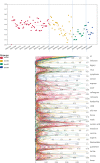Analysis of the evolving factors of social media users' emotions and behaviors: a longitudinal study from China's COVID-19 opening policy period
- PMID: 37957635
- PMCID: PMC10642066
- DOI: 10.1186/s12889-023-17160-y
Analysis of the evolving factors of social media users' emotions and behaviors: a longitudinal study from China's COVID-19 opening policy period
Abstract
The outbreak of the COVID-19 pandemic has triggered citizen panic and social crises worldwide. The Chinese government was the first to implement strict prevention and control policies. However, in December 2022, the Chinese government suddenly changed its prevention and control policies and completely opened up. This led to a large-scale infection of the epidemic in a short period of time, which will cause unknown social impacts. This study collected 500+ epidemic-related hotspots and 200,000+ data from November 1, 2022, to March 1, 2023. Using a sentiment classification method based on pre-trained neural network models, we conducted inductive analysis and a summary of high-frequency words of various emotions. This study focuses on the inflection point of the emotional evolution of social media users and the evolution of "hot topic searches" events and emotional behavioral factors after the sudden open policy. Our research results show that, first of all, the positive emotions of social media users are divided into 4 inflection points and 5 time periods, and the negative emotions are divided into 3 inflection points and 4 time periods. Behavioral factors are different at each stage of each emotion. And the evolution patterns of positive emotions and negative emotions are also different. Secondly, the evolution of behavioral elements deserves more attention. Continue to pay attention: The treatment of diseases, the recovery of personal health, the promotion of festive atmosphere, and the reduction of publicity on the harm of "new crown sequelae and second infections" are the behavioral concerns that affect users' emotional changes. Finally, it is necessary to change the "hot topic searches" event by guiding the user's behavioral focus to control the inflection point of the user's emotion. This study helps governments and institutions understand the dynamic impact of epidemic policy changes on social media users, thereby promoting policy formulation and better coping with social crises.
Keywords: Emotional evolution; Social media user behavior; Sudden policy changes.
© 2023. The Author(s).
Conflict of interest statement
The authors declare no competing interests.
Figures









Similar articles
-
A study on the emotional and attitudinal behaviors of social media users under the sudden reopening policy of the Chinese government.Front Public Health. 2023 Aug 4;11:1185928. doi: 10.3389/fpubh.2023.1185928. eCollection 2023. Front Public Health. 2023. PMID: 37601226 Free PMC article.
-
Concerns Expressed by Chinese Social Media Users During the COVID-19 Pandemic: Content Analysis of Sina Weibo Microblogging Data.J Med Internet Res. 2020 Nov 26;22(11):e22152. doi: 10.2196/22152. J Med Internet Res. 2020. PMID: 33151894 Free PMC article.
-
Long-term Effects of the COVID-19 Pandemic on Public Sentiments in Mainland China: Sentiment Analysis of Social Media Posts.J Med Internet Res. 2021 Aug 12;23(8):e29150. doi: 10.2196/29150. J Med Internet Res. 2021. PMID: 34280118 Free PMC article.
-
Chinese Public's Attention to the COVID-19 Epidemic on Social Media: Observational Descriptive Study.J Med Internet Res. 2020 May 4;22(5):e18825. doi: 10.2196/18825. J Med Internet Res. 2020. PMID: 32314976 Free PMC article.
-
Temporal and Emotional Variations in People's Perceptions of Mass Epidemic Infectious Disease After the COVID-19 Pandemic Using Influenza A as an Example: Topic Modeling and Sentiment Analysis Based on Weibo Data.J Med Internet Res. 2023 Nov 2;25:e49300. doi: 10.2196/49300. J Med Internet Res. 2023. PMID: 37917144 Free PMC article.
Cited by
-
Social media heterogeneity and preventive behaviours during the COVID-19 outbreak: a survey on online shopping.BMC Public Health. 2024 Apr 29;24(1):1193. doi: 10.1186/s12889-024-18253-y. BMC Public Health. 2024. PMID: 38679720 Free PMC article.
-
Long-Term Effects of the COVID-19 Open Strategy on the Mental Health of Chinese University Students: A Prospective Cohort Study.Health Sci Rep. 2025 Apr 6;8(4):e70609. doi: 10.1002/hsr2.70609. eCollection 2025 Apr. Health Sci Rep. 2025. PMID: 40196386 Free PMC article.
References
-
- Dubey AD. Twitter Sentiment Analysis during COVID-19 Outbreak (April 9, 2020). Available at SSRN: https://ssrn.com/abstract=3572023 or 10.2139/ssrn.3572023.
Publication types
MeSH terms
LinkOut - more resources
Full Text Sources
Medical

